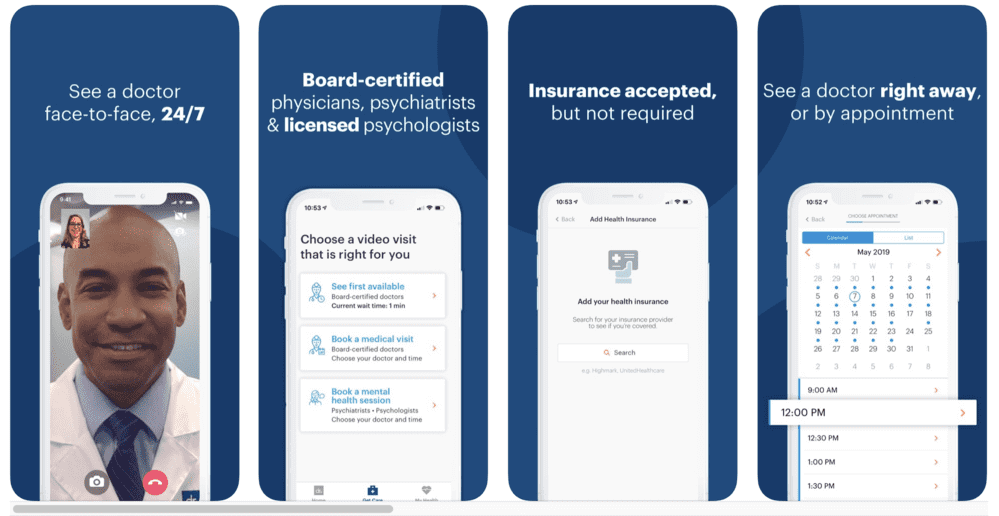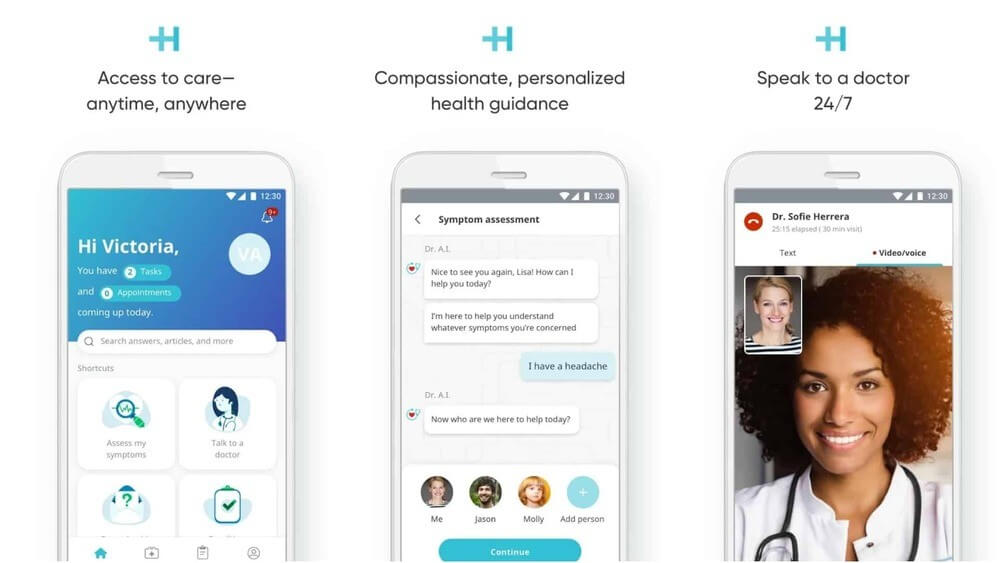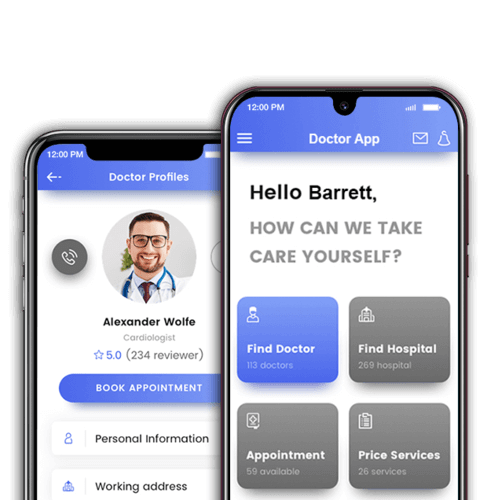The article was updated on August 26, 2022.
The pandemic gave businesses and institutions a great boost towards going digital, and the healthcare sector comes in first place. According to the latest research, in the first year of the worldwide lockdown, the global telemedicine market value was near $80 billion, almost doubling compared to the previous one, and by 2027, it’s anticipated to amount to over $396 billion.
The experience of the rising doctor on-demand sector has shown that telemedicine app development will remain relevant even after people learn to cope with COVID-19. The need for safety will be replaced with the urge for convenience. But a high-quality, on-demand doctor app can bring benefits not only to the patients but also to healthcare facilities and companies.
In this article, we will take a closer look at the advantages of doctor on-demand solutions, and offer you a comprehensive guide on how to develop a telemedicine app. Read on to learn more!
Advantages of telemedicine applications
On-demand doctor solutions minimize the risks of contracting a disease for patients who need urgent care. Yet, apart from this obvious advantage, telemedicine also has a number of other benefits.

1. Delivering urgent medical care
Initially, telemedicine was meant to cater to the underserved population. Today, on-demand doctor apps help bring medical services to patients with urgent conditions who can’t wait 24 days (the average wait time in the United States) to see their physicians, and therefore are often forced to visit emergency departments.
2. Improved access to healthcare
People in remote and rural areas no longer have to travel long-distances to visit the nearest healthcare facility. By using telemedicine apps, they can consult a physician without leaving their homes and get qualified medical care.
3. Saving time and money
Telehealth apps literally deliver medical services to your doorsteps, and patients no longer have to spend precious time commuting to hospitals. Healthcare professionals, on the other hand, can serve more patients remotely and set up a more flexible working schedule. This is an essential advantage, as doctors usually complain about a poor work-life balance.
4. Lower hospital readmissions
One of the indicators of the success or failure of a healthcare system is the hospital readmission rate: the percentage of patients who return to hospitals after the initial stay. In the United States, for example, the average hospital readmission rate is approximately 20%. Telemedicine apps help patients monitor their conditions and get timely help, without having to return to a hospital.
5. Granting unified access to electronic health records
Telemedicine apps make in-depth and accurate health data available from any location. If a patient opts for another clinic, all of their previous health records can become instantly accessible. Most importantly, the analytics systems can make predictions about potential health risks and assess patients’ current conditions based on this data.
6. Reducing paperwork
Surprising as it may seem, the traditional healthcare system is still bound by paperwork, which hampers productivity and reduces the efficiency of healthcare services. Telehealth apps, on the other hand, use the cloud to store and keep patients’ records such as a history of previous visits, doctors’ prescriptions, and recommendations.
7. Extending the choice of healthcare providers
Doctor-on-demand apps extend the patients’ choice of medical services far beyond their area of residence. Such apps can aggregate information about clinics and practitioners offering remote consultations and enabling users to choose from a number of options.
8. Attracting and retaining clients
With databases of licensed physicians fully at their disposal, patients can now easily schedule appointments and return to the doctor or clinic they’ve enjoyed interacting with. For clinics, telemedicine is an important asset, helping them keep non-disruptive operations.
9. Competitive advantage
Surveys have revealed, around 70% of patients would prefer virtual appointments over phone calls, while 77% prefer to communicate with their doctors via messengers. Telemedicine apps offer clinics a distinct competitive advantage by fully meeting these patients’ needs.
On top of that, telemedicine solutions are now finding vast application in specialties like cardiology, psychiatry, and help medical personnel carry out pre- and post-surgical examinations. On-demand doctor apps help clinics ensure non-stop operations, comply with healthcare regulations, and reduce expenses.
How does a doctor on-demand mobile app work?
Much like Twitter, telemedicine apps use patient location data to offer a choice of available professionals within their vicinity. The typical user journey looks like this:
- The patient downloads an app, sets up his profile, and submits a detailed description of the symptoms.
- The app then suggests a selection of doctors in the nearby area.
- A patient picks a doctor and a date of an online visit depending on the doctor availability.
- A consultation takes place, and the doctor recommends treatment or tests.
- The patient pays a physician or a clinic through an online payment getaway and receives the doctor’s prescriptions in a separate file.
As of today, app marketplaces will offer you several popular telemedicine apps. Before you proceed with doctor-on-demand app development, let’s take a brief look at the already existing solutions.

Examples of doctor on-demand apps
The telemedicine app sector is experiencing a period of growth. However, you have a chance to create the best doctor on-demand app so far by consolidating the most successful practices of your current competitors. Let’s briefly explore some of them.
HealthTap
HealthTap is a healthcare app for iOS and Android. The app has an in-built messaging system, a module for secure payment transactions, and tools for running and scheduling video consultations. The platform allows both men and women, children and seniors, to get professional medical support concerning a wide range of conditions.
Besides standard care, you can receive consultation about your lifestyle, prevent health issues, treat chronic conditions, and even prepare for a trip with travel-related counseling. HealthTap is available in both mobile and desktop versions.
ZocDoc
ZocDoc is a telemedicine mobile app that delivers remote healthcare services to almost 6 million patients across the US. The platform allows booking either an online appointment or a live meeting in a local office. For that, this doctor on-demand app integrates maps helping customers locate the right doctor, appointment reminders, and scheduling options.
ZocDoc also offers convenient insurance checking, so you can get to know effortlessly whether your chosen healthcare provider accepts your plan.
DoctorOnDemand
DoctorOnDemand is a robust telemedicine service with over 1,400 licensed US physicians offering their consultations. Apart from the usual features, such as in-app messaging, payment processing, and video meetings, this application has a search feature that helps users find the right specialist, cloud storage for patients’ records, and a map where users can locate the nearest pharmacies.
With this telehealth app, you can consult a healthcare expert with or without insurance. Providers can treat a great range of illnesses, including chronic ones and those related to mental health, as well as offer preventive and urgent care.

Lemonaid
Lemonaid is a highly competitive on-demand doctor app that offers 100% online in-app healthcare consultations via phone call or video chat. Besides that, this telemedicine app works like Uber for doctors. That means you can get a prescription from your doctor after an online appointment and have your medications delivered.
The platform is known for its user-friendliness, and it also presents an exhaustive FAQ section about its services and specific conditions. As for health issues, Lemonaid healthcare providers deal both with general health queries and more specific ones such as skin problems or mental health issues. The platform also makes it easier to get tested, both at home and in labs, depending on your request.
LiveHealth
LiveHealth is a telehealth doctors platform available on your smartphone, desktop, or tablet. The app allows you to choose an appropriate healthcare provider based on their profiles, and connect with the selected expert in under 10 minutes.
Your doctor or therapist will consult you on a general health issue, allergy matters, or a mental health request, as well as draw up an individual treatment plan. This plan, along with general doctor’s notes and recommendations, will be available for you after the appointment. Besides video consultations, the service allows doctors to send your prescriptions to a nearby pharmacy.
Main features of telemedicine apps
One of the things you should know before you start creating a telemedicine app is its core feature set. Apart from the attractive and convenient UI, your app functionality will set you apart from your competitors. Surely, the set of telemedicine app features for doctors will differ from the telemedicine app features for patients.
Typically, the list of features for patients will include:
- Patient’s profile: A profile contains the patient’s personal details as well as notes from previous visits for reference.
- Advanced sign-up features: Patients should be able to sign up via social media channels.
- Search: As patients search for doctors, they should be able to use filters like specialty, language, location, pricing, the type of insurance they accept. They also should be able to browse doctors’ profiles.
- Appointment scheduling: This feature uses the Calendar to define the available dates.
- Reminders: An app should send automatic reminders to patients. It should also use channels like SMS and e-mail to deliver these reminders.
- Online visits: An app should offer secure tools for remote consultations and running high-resolution videos so that the doctors can conduct remote examinations.
- Payment: Secure payment processing is a critically important feature of doctor-on-demand apps. As of today, the top-rated payment gateway API providers for healthcare include: Stripe, PayPal, Braintree, Square. Ideally, your doctor-on-demand platform should support different methods of payment, such as credit cards, employer coverage, coupons, and insurance.
- Feedback: An app should enable patients to leave testimonials and rate physicians according to patient feedback.
- Promotions and referrals: Patients should be able to receive info about discounts and promotions, and profit through referrals.
- Dealing with emergencies: In healthcare, an urgent response can be a lifesaver. A telehealth app should enable users to call an ambulance with a single screen tap.
- Ordering prescribed medications: Patients should be able to order prescription drugs. Your app could include an integrated online marketplace for purchasing medications and enable patients to receive them via home delivery, in case they can’t pick them up by themselves.

Features of telemedicine apps for doctors:
- Profiles: Doctors should be able to create their profiles where they would list their specialty, experience, fees, types of insurance they accept, etc.
- Doctor panel: This panel should grant doctors access to patients’ electronic health records, information about previous visits, drug prescriptions, and pending appointments.
- Scheduling tools: The app should enable doctors to manage their schedules and optimize workflow.
- Appointment management: The app should also enable doctors to accept and reject patient appointments.
- EHR access: The app should integrate with EHR systems and grant doctors access to patients’ health records.
- Treatment prescriptions: The doctors should be able to prescribe treatment and medication via a telemedicine app.
- In-app messaging: Messaging is a convenient communication tool for both doctors and patients. In healthcare, though, you have to be extra careful to use only 100% secure platforms for in-app messaging, since it will be used to exchange personal and sensitive data.
- Document scanning and sharing: A telehealth app should be able to securely capture and transmit large amounts of medical information such as medical images, lab test results, treatment prescriptions, etc.
Typical features of the admin panel
The admin panel should be visible only to telemedicine app administrators, and should contain such features as
- managing patients and doctors
- marketing tools
- communication channels
- a notification module
- CMS for News and Articles
- real-time analytics
- report generation
On top of that, on-demand doctor solutions should include matching opportunities: i.e. matching doctors and patients using location, symptoms, and other data.
Envisioning a user journey will help you decide on the functionality you want to include in your product. For example, in the DoctorOnDemand app the user journey starts with entering the symptoms, while in other apps it may start with locating the physicians in the nearby area.

Things to consider when developing a doctor on-demand app
If you want to learn how to develop a telemedicine app, a list of features isn’t enough. Here are some more things to consider, if you plan to enter a lucrative market of on-demand doctor solutions.
1. Your target audience
Before you plunge into telemedicine application development, know your target audience. Who are the people most likely to be using your app? What are their demographics, income, and social status? Will you compete with other apps in this segment, or will you be filling a previously untapped niche?
2. Extensive database of doctors and healthcare practitioners
No telemedicine app is possible without a good doctors’ database. Make sure to include certified practitioners, so that your doctor-on-demand app could have all it takes to become a trusted source of medical help.
To build this database, contact healthcare organizations in the area of app coverage. You can buy commercial marketing databases with contact details of clinics, physicians, dentists, and other healthcare providers in that area. Invite them to register in your app and fill in doctor profiles.
Another important thing to consider is license verification. Make sure doctors can only register in your app if they upload a scanned copy of a license and diploma. Build a verification system that will verify doctors’ licenses by number.
3. Your monetization model
How are you going to earn revenue with your Doctor-on-Demand app? All in all, the most common monetization models for online doctor apps are:
- Featured listing – doctors and physicians pay to get listed in your app.
- Commission-based – the app gets a royalty from each doctor-patient transaction.
- In-app advertising – here, the app gets revenue from advertising the services of healthcare providers.
- Membership – users get access to the platform for an annual or monthly fee.
- Software as a service – the healthcare service provider (e.g., hospitals) pays a fee for each employee user.
- Per-minute charge – the platform charges patients a small sum for each minute of a phone or video consultation.
The revenue model you choose will determine the type of user interface you will build for your doctor-on-demand app and, ultimately, the customer journey.

4. Legal matters
Healthcare is a highly regulated industry, and if you plan to enter the telemedicine app market, your solution must be 100% compliant to all regulations, certifications, and acts such as GDPR in the EU and HIPAA in the United States.
5. Development budget
Building solutions and applications for healthcare involves expenses. Make sure your budget is strong enough to invest in telehealth app development.
One thing which is surely crucial to building doctor-on-demand apps is the choice of a tech partner. Your app features, the development tech stack, the timeline, and expenses will depend on the success of this partnership. Experienced software developers will also make sure your app is future-ready and will integrate with emerging technologies like 5G, blockchain, and virtual reality.
Wrapping up
Doctor on-demand app development has become part and parcel of the new norm in the medical industry. Yet, with all its benefits both for businesses and patients, it will remain in high demand for the unforeseen future.
If you wish to step up your business and stay competitive in your field, it’s high time to come up with your own doctor on-demand app or find a reliable partner team that knows how to develop a telemedicine app according to all industry standards.
Want to tap into the potential of telemedicine app development? Contact us now for a free consultation!
Read also:



